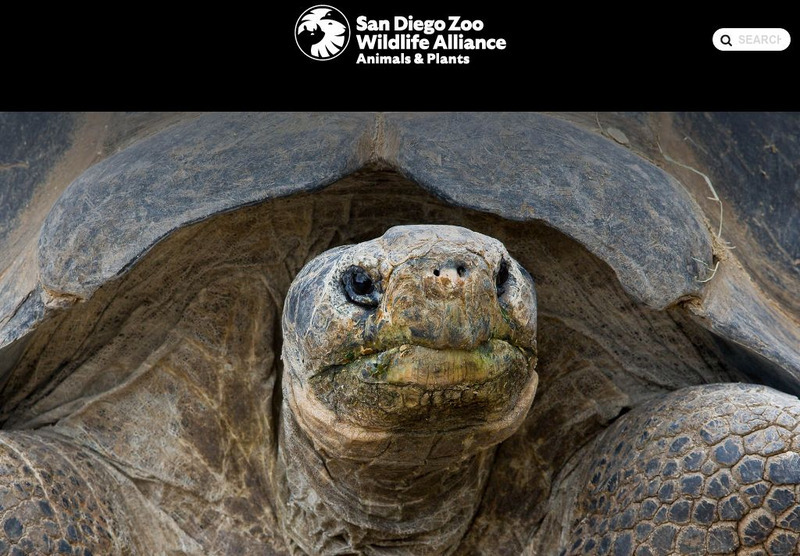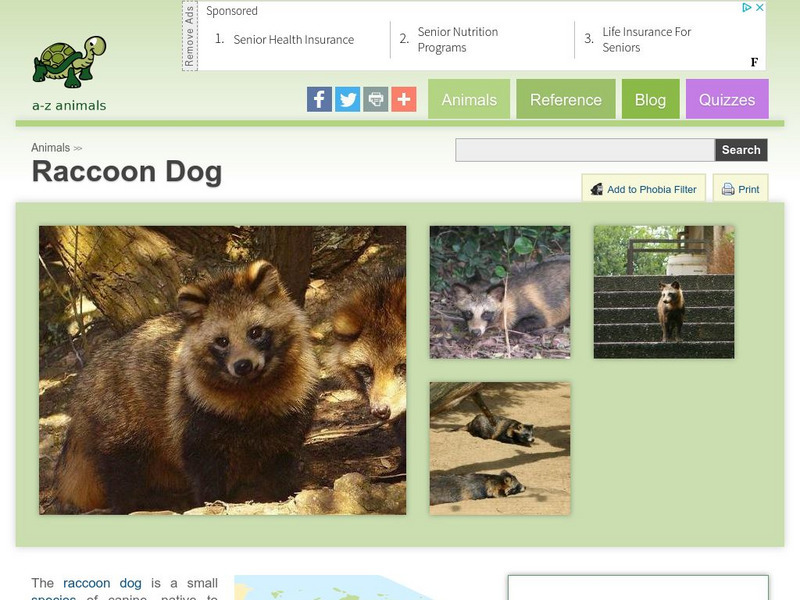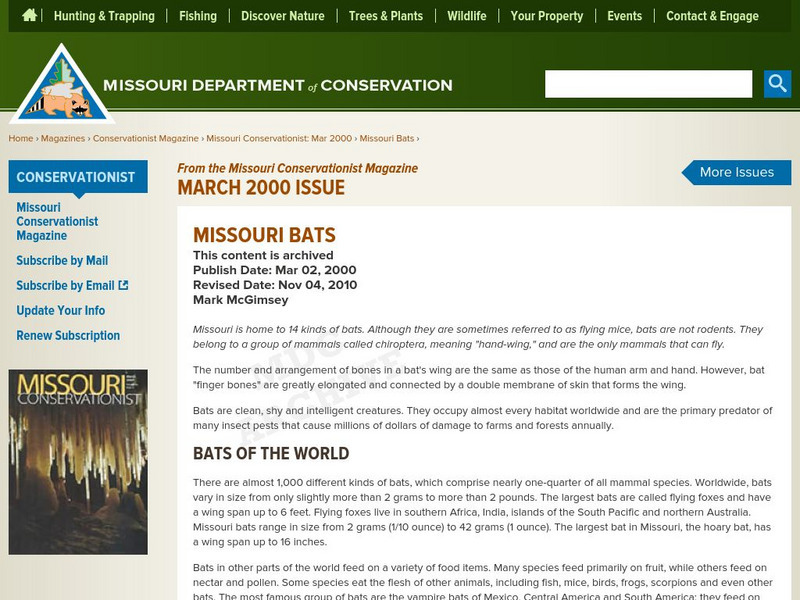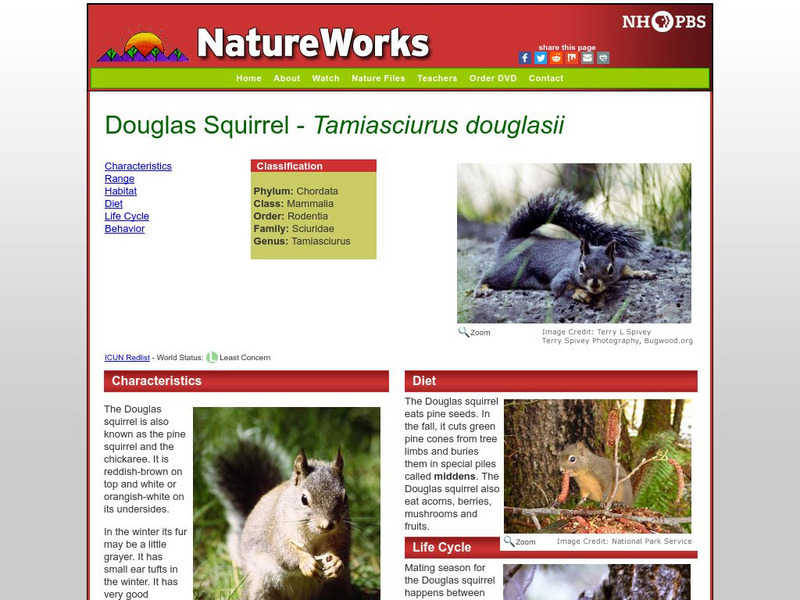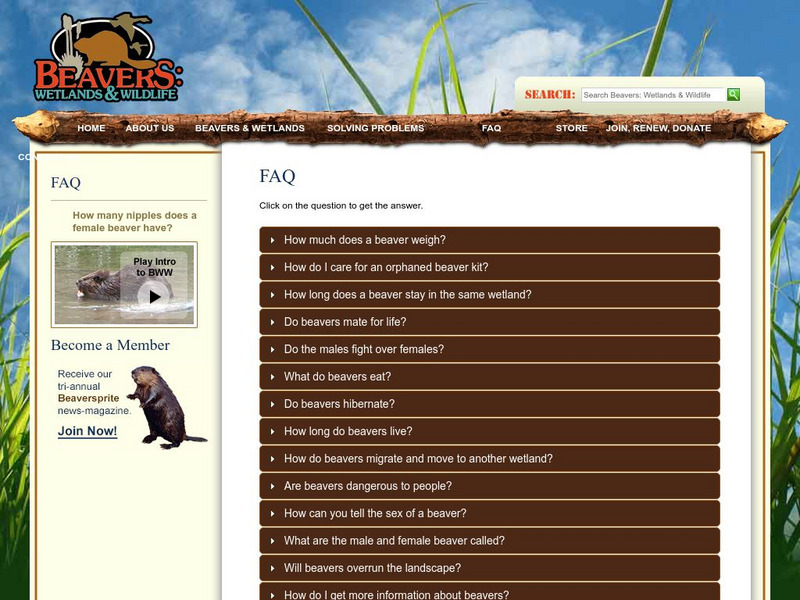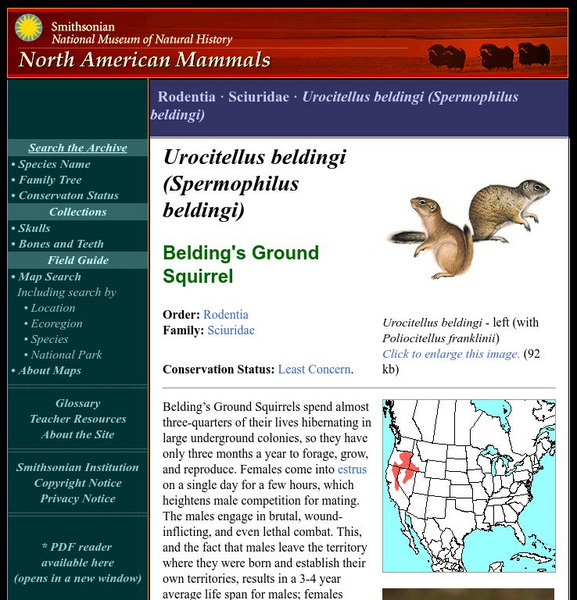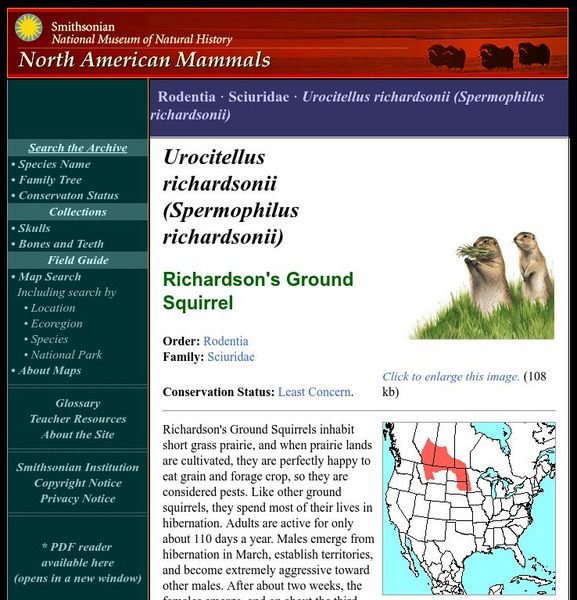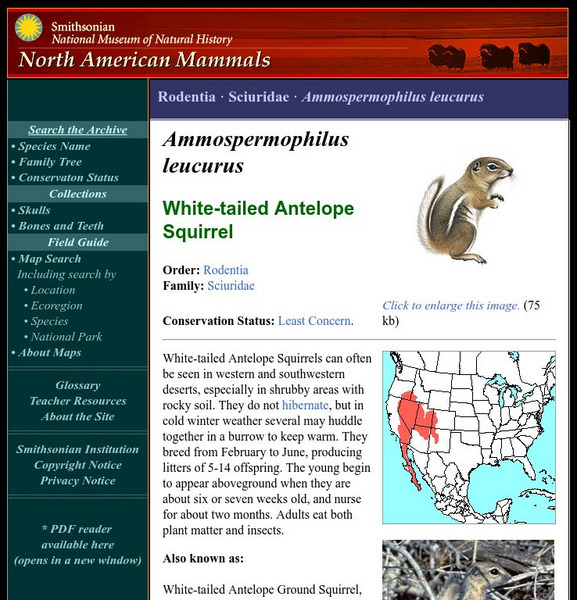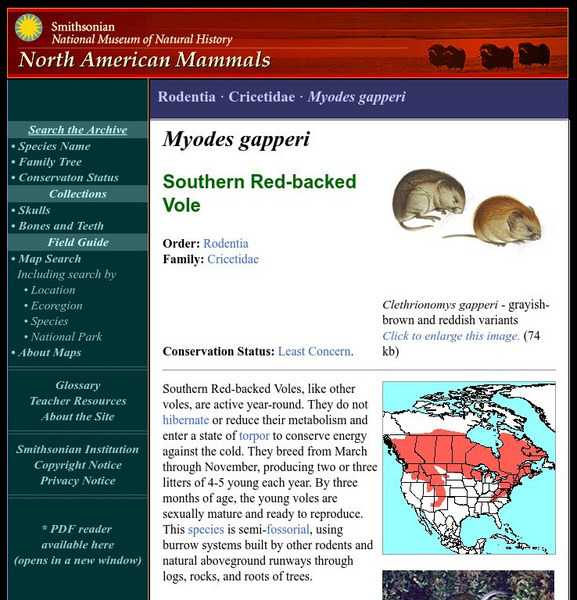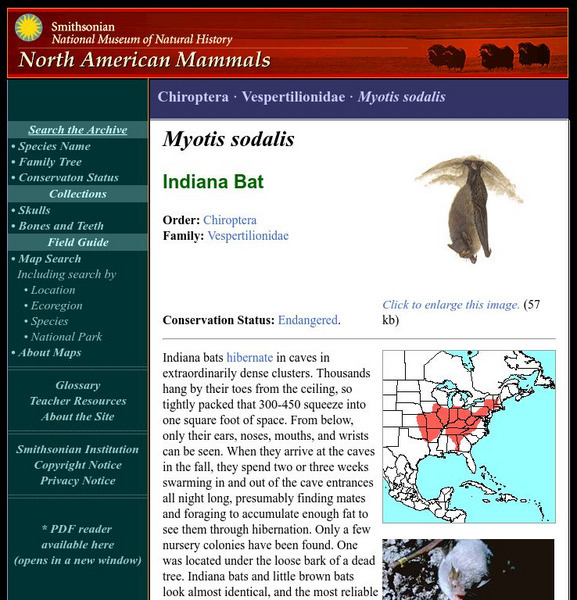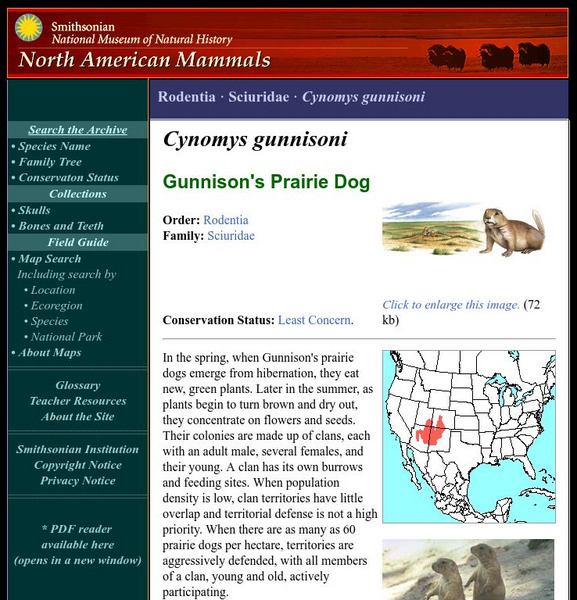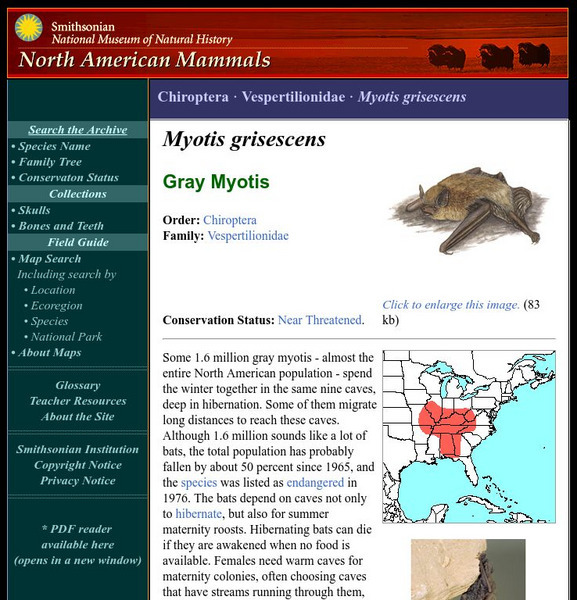San Diego Zoo Global
San Diego Zoo: Galapagos Tortoise
This resource provides detailed information about the Galapagos tortoise, as well as several pictures.
A-Z Animals
A Z Animals: Animal Facts: Raccoon Dog (Nyctereutes Procyonoides)
Provides photographs and a fact card about the raccoon dog. Discusses how they are similar to raccoons, where they are found, the unusual fact that they hibernate, the threat they face from deforestation, diet, predators, and lifespan.
Other
Missouri Conservationist Online: Missouri Bats
This site provides some good overall information on bats. It provides statistical data about bats of the world, information on what bats eat, hibernation, reproductive habits, bat myths, benefits of bats, and lists some endangered bats.
Better Lesson
Better Lesson: Student, Student, What Do You See?
Most bears are getting ready to hibernate this time of year. NOT IN MY ROOM! These little brown bears will be on the hunt for shapes they see.
PBS
Pbs: Modeling Fraction Division Using Comparison, Group Number Unknown
This animated video illustrates a visual model for solving a word problem involving the division of fractions. The problem asks students to use fractions to compare the spring weight of a hedgehog with its weight just before hibernation....
Utah Education Network
Uen: Science Vocabulary Game
Fourth graders will play a review memory game with Utah's Grade 4 Science Standard V vocabulary words during this activity. Words associated with living things and classifications of living things are included in this activity.
Utah Education Network
Uen: Learning the Effects of Weather
Learn how weather affects people and animals.
Utah Education Network
Uen: Animal Adaptations
A multitude of activities provide help with understanding animal adaptations.
PBS
Dialogue for Kids: Bear Facts & Information
This Dialogue for Kids site by the Idaho Department of Fish and Game features detailed information on bears, their lifestyle, habitat, and much more. Links and lesson plans can be found here as well.
Read Works
Read Works: Get Ready for Winter
[Free Registration/Login Required] This passage is a stand-alone curricular piece that reinforces essential reading skills and strategies and establishes scaffolding for vocabulary learning. It can be used as both a read-aloud exercise...
PBS
Nh Pbs: Nature Works: Douglas Squirrel (Pine Squirrel)
This resource created by NatureWorks focuses on the Douglas Squirrel. The site includes a look at this species' characteristics, range, habitat, diet, life cycle, and behavior.
Smithsonian Institution
National Museum of Natural History: American Mammals: American Black Bear
Most Black Bears hibernate for up to seven months, and do not eat, drink, urinate, or exercise the entire time. In the South, where plant food is available all year, not all bears hibernate, but pregnant females do. Learn more about the...
Smithsonian Institution
National Museum of Natural History: American Mammals: Mohave Ground Squirrel
The Mohave Ground Squirrel occupies a relatively tiny part of the Mohave Desert and is rarely seen since it spends more than half the year underground in a burrow. Estivation, the hot-weather equivalent of hibernation, and hibernation...
Other
Anapsid: Garter Snakes
A detailed summary of Garter Snakes including natural history, hibernation, reproduction, predation, housing, feeding, handling, medical problems, and resources.
Other
Beavers: Frequently Asked Questions & Answers
Did you know that beavers are vegetarians that do not hibernate and are rarely dangerous to people? You will find more beaver facts in this informative question and answer site.
Smithsonian Institution
National Museum of Natural History: American Mammals: Belding's Ground Squirrel
Belding's Ground Squirrels spend almost three-quarters of their lives hibernating in large underground colonies, so they have only three months a year to forage, grow, and reproduce. Females come into estrus on a single day for a few...
Smithsonian Institution
National Museum of Natural History: American Mammals: Richardson's Ground Squirrel
Richardson's Ground Squirrels inhabit short grass prairie, and when prairie lands are cultivated, they are perfectly happy to eat grain and forage crop, so they are considered pests. Like other ground squirrels, they spend most of their...
Smithsonian Institution
National Museum of Natural History: American Mammals: Northern Long Eared Myotis
Although the northern long-eared myotis is common and widespread, much remains to be learned about its roosting habits, reproduction, and longevity. This bat is known to hibernate in caves and mines and to roost under tree bark. Learn...
Smithsonian Institution
National Museum of Natural History: American Mammals: White Tailed Antelope Squirrel
White-tailed Antelope Squirrels can often be seen in western and southwestern deserts, especially in shrubby areas with rocky soil. They do not hibernate, but in cold winter weather, several may huddle together in a burrow to keep warm....
Smithsonian Institution
National Museum of Natural History: American Mammals: Southern Red Backed Vole
Southern Red-backed Voles, like other voles, are active year-round. They do not hibernate or reduce their metabolism and enter a state of torpor to conserve energy against the cold. Learn more about the Clethrionomys gapperi, more...
Smithsonian Institution
National Museum of Natural History: American Mammals: Dark Kangaroo Mouse
Kangaroo Mice have fat deposits in the middle of their tails. The fat deposits change in size according to the season, being largest when the animals go into hibernation and smallest when they emerge in the spring. Learn more about the...
Smithsonian Institution
National Museum of Natural History: American Mammals: Indiana Bat
Indiana bats hibernate in caves in extraordinarily dense clusters. Thousands hang by their toes from the ceiling, so tightly packed that 300-450 squeeze into one square foot of space. Learn more about the Myotis sodalis, more commonly...
Smithsonian Institution
National Museum of Natural History: American Mammals: Gunnison's Prairie Dog
In the spring, when Gunnison's prairie dogs emerge from hibernation, they eat new, green plants. Later in the summer, as plants begin to turn brown and dry out, they concentrate on flowers and seeds. Learn more about the Cynomys...
Smithsonian Institution
National Museum of Natural History: American Mammals: Gray Myotis
Some 1.6 million gray myotis - almost the entire North American population - spend the winter together in the same nine caves, deep in hibernation. Learn more about the Myotis grisescens, more commonly known as a Gray Myotis, in this...
Other popular searches
- Animals Who Hibernate
- Amphibians That Hibernate
- Animals That Hibernate
- Do Starfish Hibernate
- Animals Hibernate
- Seven Animals Who Hibernate
- Migrate and Hibernate
- Ocean Animals Hibernate
- Seasons Hibernate
- Do Aye Ayes Hibernate
- Do Invertebrates Hibernate
- What Animals Hibernate


